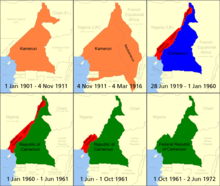South Cameroon
Südkamerun (English: South Cameroons ) is a part of Cameroon in the west, which was British trustee territory from 1922 to 1961 after the end of German colonial rule , while the rest of the country was under French trusteeship. To this day, South Cameroon is predominantly English-speaking, while the rest of Cameroon is francophone. Parts of the South Cameroonian population feel marginalized in the entire state of Cameroon and are striving for the independence of the area. You also use the term Ambazonia or Ambazania for South Cameroon .
history
Colonial times
After Germany the First World War was lost, the German colony of Cameroon as the other German colonies became a League of Nations mandate territory. After New Cameroon, which was acquired by France in 1911, was separated and fell under French administration again, the mandate of Cameroon was divided up between the victorious powers Great Britain and France on June 28, 1919 . While France received the greater eastern part, Great Britain was assigned a narrow strip of territory in the west on the border with Nigeria as British Cameroon . British Cameroon was divided into a southern zone ( South Cameroons ) and a northern zone ( North Cameroons ).
After the founding of the United Nations in 1945, the mandate areas became UN trust areas.
Independent Cameroon
On January 1, 1960, France granted French Cameroon independence in accordance with the mandate provisions. Previously, on March 13, 1959, the UN General Assembly passed resolution 1350, which provided for referendums in northern and southern British Cameroon on the future of this area. On January 11 and 12, 1961, the residents of British Cameroon were able to vote in a vote between joining the neighboring English-speaking Nigeria and autonomy within Cameroon; complete independence was not an option. While the northern part opted for Nigeria, the southern part - today's South Cameroon - remained with Cameroon. The granted autonomy rights of South Cameroon were noticeably dismantled by the centralized constitution of the entire state. The standardization of the education system in French caused displeasure among the English-speaking South Cameroonians, who felt disadvantaged by it.
Aspirations for independence
After a possible independence did not play a role for a long time, the author Fon Fongum Gorji-Dinka wrote a pamphlet called The New Social Contract in 1985 , in which he called for the independence of South Cameroon. He was then immediately brought before a military tribunal, where he was acquitted.
In the early 1990s, a student organization was formed to liberate Ambazonia, which was a success in 2001: a Nigerian court forbade the Nigerian government to continue to call the citizens of Ambazonia "Cameroonians" and called on Cameroon to take steps in this direction to undertake an independence from Ambazonia.
In 1999 the non-violent secessionist organization Southern Cameroons National Council (SCNC) declared Ambazonia's independence. In 1999 and 2000 there were demonstrations and also riots by secessionists. Since 2004 the SCNC has been a member of the UNPO on behalf of South Cameroon . In 2006 the Southern Cameroons People's Organization (SCAPO) again proclaimed the independence of Ambazonia, including the Bakassi Peninsula .
On October 1, 2017, the "Republic of Ambazonia" was proclaimed again after a year of unrest. All declarations of independence were unsuccessful. In 2017, the separatists formed several armed groups that made some towns “ungovernable” and fought with the army. In some cases they were supported by the population. Army units such as the elite BIR were accused of setting fire to villages in which they suspected rebels or their supporters and of torturing alleged rebels. According to Amnesty International, the rebels are also believed to have committed atrocities. The International Crisis Group estimated before the presidential election in October 2018 that the conflict had already fallen at least 420 civilians, 175 military personnel, as well as hundreds of rebels victim. Over 246,000 people were internally displaced , and another 25,000 fled across the border into Nigeria. On February 12, 2020, security forces killed 23 civilians in Ntumbo village; the United Nations called for an investigation. At the same time, the total number of fatalities in the riots was given as almost 3,000, and the number of internally displaced persons as over 700,000.
supporting documents
- Le Monde diplomatique: No to assimilation - secessionist efforts in Cameroon.
- Indymedia.de: Ambazonia - A forgotten country in Africa.
Individual evidence
- ↑ Katharina Lipowsky: “People want their pride back.” The daily newspaper of October 13, 2017, p. 11.
- ^ Farouk Chothia: Cameroon's Anglophone crisis: Red Dragons and Tigers - the rebels fighting for independence. In: BBC . October 4, 2018, accessed October 6, 2018 .
- ↑ Cameroon: Divisions Widen Ahead of Presidential Vote. International Crisis Group , October 3, 2018, accessed October 6, 2018 .
- ^ Cameroon's international partners call for investigation into village massacre. africanews.com, February 19, 2020, accessed February 19, 2020


